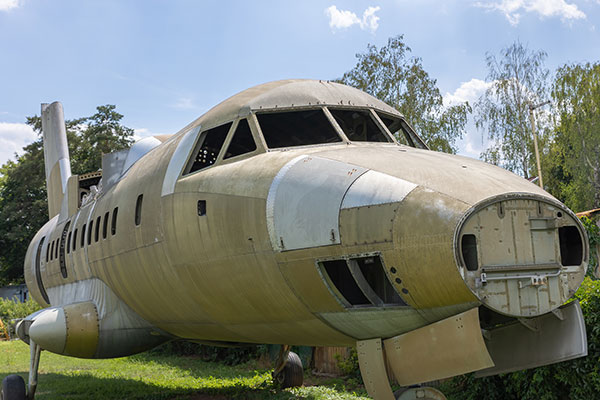Wingless Wonder: Supreme Court of Alaska Defines “Aircraft” as Less than the Sum of its Parts

What is a fuselage without wings, elevators or a tail rudder?
An airplane, according to the Supreme Court of Alaska’s recent decision of Thompson v. USAA, 2024 WL 296380 (Alaska January 26, 2024).
Thompson centered on a 1946 Piper PA-12 airplane that had failed its annual inspection and was no longer airworthy. To make repairs, Matthew Mrzena, the airplane’s owner, removed the wings, tail rudder and elevators from the fuselage. While in this state, Mrzena maintained registration of the Piper with the Federal Aviation Administration (“FAA”) as well as an aircraft owner-specific liability policy on the Piper with Avemco Insurance Company (“Avemco”).
Mrzena stored the airplane in a temporary garage until he and his now-wife (Lisa Thompson) purchased a new residence—nearly five years after Mzrena had first removed the exterior fabric covering of the Piper. In the process of moving their belongings, the Piper needed to be pushed out of the garage and onto a trailer. Mrzena pushed from the back of the Piper, with Thompson at the front, when she became pinned under the Piper’s nose, enduring severe injuries.
Thompson sued Mrzena to recover damages for her injuries pursuant to his homeowner’s insurance policies with USAA. Following a $57,000 settlement among Mrzena, Thompson and Avemco, USAA filed a separate state action seeking a declaration that Thompson’s personal injury claims were excluded from coverage under identical USAA homeowner’s insurance policies.
At issue was whether Thompson’s injuries “arose out of the ownership or use of an aircraft.” In this respect, the trial court noted that “arising out of” required only “some causal connection” between the injury and the activity—not a strict proximate cause determination. As such, the court reasoned that “even if Thompson’s injuries were proximately caused by only part of an aircraft, the injuries may still be causally connected to the ownership of an aircraft.” (Emphasis added.)
The court then turned to the definition of “aircraft” under the policy to assess whether, at the time of the incident, Mrzena owned an aircraft and whether Thompson and he were using an aircraft. As a starting point, the court recognized that the policy defined “aircraft” as “any conveyance used or designed for flight, except model or hobby aircraft not used or designed to carry people or cargo.” USAA argued that aircraft parts like a fuselage were part of this definition of “aircraft” because “designed” means “planned or conceived in detail or for a specific purpose” and the aircraft parts were designed for flight. Thompson offered a contrary view, arguing that “conveyance” meant “a means of transport,” and that a fuselage could not be considered a means of transport because it was only “part” of an aircraft.
The superior court sided with USAA, concluding that “[t]he phrase ‘conveyance used or designed for flight’ must be read as a whole.” And considering the reasonable expectations of the insured, the superior court concluded that “[n]o reasonable person would expect” that an insured no longer owned an aircraft solely because the aircraft had been “partially disassembled to make repairs . . . particularly . . . given that the policies exclude coverage for injuries arising out of ‘maintenance’ of an aircraft,” which often requires removing parts. The superior court thus rejected Thompson’s argument that the policy’s definition of “aircraft” should result in coverage of an injury incurred while moving inoperable parts, describing her argument as “unreasonably narrow[ing] the aircraft exclusions” to require proximate cause, with exclusions only applicable to a fully assembled, operable plane.
The superior court also took into consideration extrinsic evidence concerning the insured’s reasonable expectations, specifically referencing a photograph depicting the state of the Piper at the time of Thompson’s injury. In its assessment, while the Piper’s wings and a portion of its tail had been removed, the fuselage remained connected to other components, including the landing gear and propeller. Furthermore, the only parts requiring repair had seemingly been removed and the Piper still bore the size and form typical of an aircraft. Consequently, “a reasonable person would readily be able to identify the Piper . . . as an aircraft.” Additionally, Mrzena’s consistent registration of the Piper with the FAA over the years, along with his efforts to secure aircraft liability insurance for the Piper, were probative of the Piper’s status as an “aircraft.”
Thompson appealed, contending that the superior court misinterpreted the USAA policies. The Supreme Court of Alaska affirmed the lower court’s decision, however.
The Supreme Court of Alaska first approached the language of USAA’s aircraft exclusion from the perspective of the “reasonable expectations of the lay insured.” In doing so, it held that the policy’s exclusion of coverage for injuries arising out of the ownership or maintenance of an aircraft applied. “Regardless of whether the Piper was an airplane or a collection of airplane ‘parts’ when it injured Thompson,” Justice Henderson wrote, “the injury arose out of Mrzena’s ownership.” As such, given the clear language of the policy exclusion, “it would be unreasonable to limit the scope of the aircraft exclusion to accidents occurring only while the aircraft is fully assembled and operable.” The Supreme Court of Alaska also found this conclusion consistent with other of its precedents holding that a reasonable person interpreting broad exclusions for ownership, maintenance and use would understand that an aircraft exclusion was intended to create “broad exclusions” for incidents involving a homeowner’s airplane.
In this respect, the Supreme Court of Alaska was not persuaded by Thompson’s argument that the USAA policy’s separate provisions on property damage demonstrated that “USAA knew how to distinguish . . . ‘parts’” from a thing itself and that this narrowed the exclusion of coverage for personal injuries arising out of the ownership or maintenance of an aircraft.” Rather, the Thompson court observed that the property section stated that the policy did not cover “motor vehicle(s)” including but not limited to” ‘aircraft’ and parts.” As such, the property section involved damage to things, not bodily injury and “crucially, the property section [did] not use ‘arising out of’ language in describing coverage, or exclusions from coverage, for property damage. Adopting Thompson’s reasoning would disregard important differences in the language of the separate sections of the policy[,]” therefore.
Thompson also failed to persuade the Supreme Court of Alaska that the Piper was not an “actual aircraft” and became mere “aircraft parts” prior to her injury. For this position, Thompson relied upon Dinocenzo v. Aitken, an Arizona decision applying Alaska law, which deemed a fuselage described as an “inert hulk kept as a source of spare parts” in the Arizona desert not to be an airplane because it could no longer fly. 827 P.2d 478 (Ariz. App. 1991).
Dinocenzo was readily distinguishable, however. First, having determined that Thompson’s injuries “arose out of” Mrzena’s ownership of the Piper,” the Supreme Court of Alaska had no need to determine whether the Piper was an aircraft or mere “parts” at the time of injury. Second, the relevant USAA policies defined “aircraft” as “any conveyance used or designed for flight …” whereas the Dinocenzo court used a dictionary definition of “aircraft” as a machine “capable of flight.” (The Thompson court also distinguished Dinocenzo in that the fuselage there was a bare “carcass” in the Arizona desert with no engine or instruments, whereas the Piper at issue only had three components missing, with all other components intact, including the engine, propeller, flight controls, other internal components, cockpit, seats, doors, landing gear, brakes and partial tail assembly. And while the Dinocenzo fuselage was used merely as a source of spare parts, the Piper was neither abandoned nor beyond repair; Mrzena testified that he removed the wings, tail rudder and elevator temporarily to repair them and began the process of re-covering each part in fabric.)
In the final analysis, though the conclusion that a fuselage without wings, elevators or a tail rudder is an airplane may seem unexpected or confounding from a practical perspective, Thompson animates enduring principles of insurance law, including that courts construe insurance policies to honor a lay insured’s reasonable expectations, that liability of an insurer is determined by reference to the language, and that policy language is construed in accordance with ordinary and customary usage.
About Timothy M. Ravich

Timothy M. Ravich concentrates his practice in the areas of aviation, product and general civil litigation. Recognized as one of only 50 lawyers qualified as a Board-Certified Expert in the area of aviation law, Tim specializes in transactional and regulatory matters related to the ownership, maintenance and utilization of aircraft, airports and airspace. Click here to read Tim’s full attorney biography.
